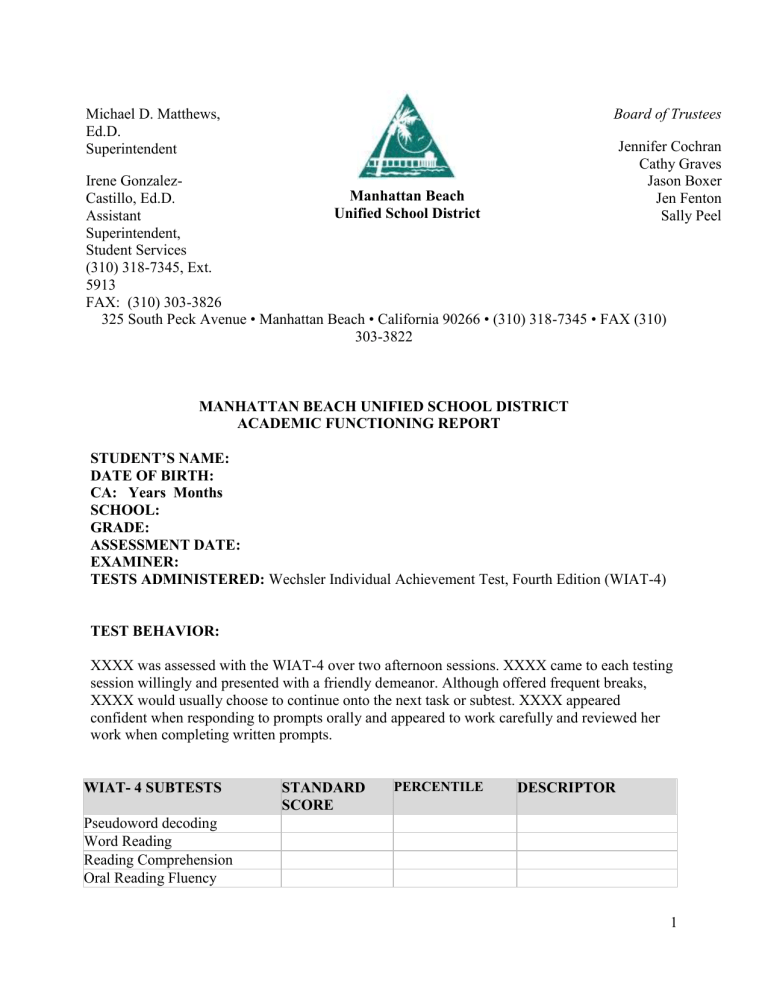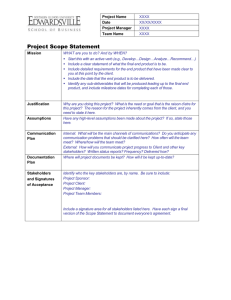
Michael D. Matthews, Ed.D. Superintendent Board of Trustees Jennifer Cochran Cathy Graves Jason Boxer Jen Fenton Sally Peel Irene GonzalezManhattan Beach Castillo, Ed.D. Unified School District Assistant Superintendent, Student Services (310) 318-7345, Ext. 5913 FAX: (310) 303-3826 325 South Peck Avenue • Manhattan Beach • California 90266 • (310) 318-7345 • FAX (310) 303-3822 MANHATTAN BEACH UNIFIED SCHOOL DISTRICT ACADEMIC FUNCTIONING REPORT STUDENT’S NAME: DATE OF BIRTH: CA: Years Months SCHOOL: GRADE: ASSESSMENT DATE: EXAMINER: TESTS ADMINISTERED: Wechsler Individual Achievement Test, Fourth Edition (WIAT-4) TEST BEHAVIOR: XXXX was assessed with the WIAT-4 over two afternoon sessions. XXXX came to each testing session willingly and presented with a friendly demeanor. Although offered frequent breaks, XXXX would usually choose to continue onto the next task or subtest. XXXX appeared confident when responding to prompts orally and appeared to work carefully and reviewed her work when completing written prompts. WIAT- 4 SUBTESTS STANDARD SCORE PERCENTILE DESCRIPTOR Pseudoword decoding Word Reading Reading Comprehension Oral Reading Fluency 1 Phonemic Proficiency Decoding Fluency Orthographic Fluency Reading Composite Basic Reading Composite Decoding Composite Orthographic Processing Composite Phonological Processing Composite Spelling Sentence Combination Sentence Building Essay Written Expression Composite Numerical Operations Math Problem Solving Math Composite Receptive Vocabulary Oral Discourse Comp. Listening Comprehension Expressive Vocabulary Oral Word Fluency Sentence Repetition Oral Expression INTERPRETATION OF TEST RESULTS: XXXX was administered the Wechsler Individual Achievement Test-Fourth Edition (WIAT-4) to assess her academic achievement or developed knowledge from her educational experiences. The WIAT-4 test includes seventeen subtests that measure Listening, Orthographic Processing, Reading, Written Language, Oral Expression, and Mathematics skills. The WIAT-4 scores show how well XXXX did compared to a group of students at the same grade level from across the United States. Scores on this test that have a mean of 100; from 90 to 110 are considered average. Detailed information regarding each composite score and subtest is explained in the following paragraphs. READING: Word Reading. The Word Reading subtest from the WIAT-4 is designed to measure letter and letter-sound knowledge and single word reading. In Part 1 examinees identify letters and match letters to sounds. In Part 2, examinees read aloud a list of regular and irregular words. XXXX’s ability in Word Reading was in the average range and at the 30th percentile. Some words that XXXX was able to read successfully include: radiant, interject, garnish, tough, ruin, budge, photograph and manage. Some errors observed included reading a replacement word with similar beginning sounds and word parts. For example, she read chore for choir, disconnect for distance, and playful for playfully. Additional errors included reading coast-en for custodian, rel-ish-ous for ridiculous, sec-ur-il-y for surgery, and rime-ee for rhyme. Reading Comprehension. The Reading Comprehension subtest from the WIAT-4 measures reading comprehension skills at the level of the word, sentence, and passage. Early items require examinees to match pictures with words to demonstrate comprehension. Sentence-level comprehension items require examinees to read a sentence and then answer literal questions about it. To measure passage comprehension, examinees read narrative and expository passages and answer literal and inferential comprehension questions asked by the examiner. Examinees can refer to the passage as needed to answer the questions. XXXX opted to read the selections silently. XXXX scored in the average range and at the 34th percentile on the Reading Comprehension subtest. XXXX answered seven out of twelve (58%) of the literal questions correctly, and seven out of eight (88%) of the inferential questions correctly. She responded to all questions about narrative text correctly. Her six errors were responses to questions for an expository passage. Oral Reading Fluency. For the Oral Reading Fluency subtest from the WIAT-4, examinees read two passages aloud. The subtest standard score is based on the average number of words read correctly per minute across the two passages. Examinees answer a comprehension question after reading each passage to encourage reading with comprehension, but comprehension does not factor into the score. XXXX responded to one of the two reading comprehension questions correctly. XXXX scored in the average range and at the 30th percentile for the oral reading fluency subtest. XXXX read passages with an average of 87% accuracy and an average of 75 words correct per minute. Pseudoword Decoding. The Pseudoword Decoding subtest from the WIAT-4 is designed to measure phonic decoding skills. Examinees read aloud a list of pseudowords. XXXX performed in the low average range of functioning and the 18th percentile. Examples of words read correctly include: caft, plid, droy, snay, dreep, rith, and sluck. Sound insertions were observed in some errors. For example, XXXX read “jroom,” for “joom;” “lirist,” for “lirst;” and “glatch-t,” for “glatch.” Another error was substituting a long vowel for a short vowel, for example she read “cheed,” for “ched.” Decoding Fluency. The Decoding Fluency subtest is designed to measure phonic decoding fluency. Examinees read aloud a list of pseudowords as quickly as possible during two timed trials. XXXX scored within the average range and the 25th percentile. She was able to read an average of …..pseudowords correctly in thirty seconds. Orthographic Fluency. The Orthographic Fluency subtest from the WIAT-4 is designed to measure an examinee’s orthographic lexicon, or sight vocabulary. Examinees read aloud a list of irregular words as quickly as possible during two timed trials. XXXX scored in the average range and at the 30th percentile on this subtest. She was able to read an average of ….words correctly in thirty seconds. Phonemic Proficiency. The Phonemic Proficiency subtest from the WIAT-4 measures the development of phonological/phonemic skills. Examinees respond orally to items that require manipulation of sounds within words. Tasks include elision, substitution, and reversal of sounds. Items are presented via audio recording. Corrective feedback is provided by the examiner on all items, and scoring incorporates both speed and accuracy. XXXX performed within the average range and the 47th percentile on the Phonemic Proficiency subtest. XXXX answered fifteen out of eighteen of the elision prompts correctly. Of the fifteen correct, fourteen were instant responses. She answered ten out of twelve of the substitution prompts correctly, of which six were instant responses. XXXX’s response to four out of eight reversal prompts were correct, however none of the reversal responses were instant. Reading Composite. XXXX scored in the average range and in the 27th percentile for the overall Reading Composite (which was composed of XXXX’s WIAT-4 Word Reading and Reading Comprehension subtests). The Decoding Composite, assesses for phonemic awareness and phonics skills and is comprised of XXXX’s WIAT-4 Pseudoword Decoding and Word Reading scores. XXXX’s Decoding Composite was in the low average range and the 19th percentile. The Phonological Processing Composite assesses for the ability to use the sounds of language (i.e., phonemes) to process spoken and written language. This composite is composed of the WIAT-4 Pseudoword Decoding and Phonemic Proficiency subtests. XXXX’s Phonological Processing Composite was in the average range and at the 27th percentile. The Orthographic Processing Composite assesses for the ability to accurately recognize familiar letter patterns either as whole words or within words and is comprised of XXXX’s Orthographic Fluency and Spelling Subtests. XXXX’s Orthographic Processing Composite was in the average range and at the 32nd percentile. Dyslexia Index. The Dyslexia Index analyzes the examinee’s WIAT-4 Pseudoword Decoding, Orthographic Fluency, and Word Reading subtests and generates a score that indicates the examinee’s risk for Dyslexia. XXXX’s risk for Dyslexia was noted to be in the low range. WRITTEN LANGUAGE: Spelling. The Spelling subtest from the WIAT-4 measures written spelling from dictation. Examinees write words that are dictated within the context of a sentence. For early items, examinees write letters that represent sounds. XXXX scored in the low average range and at the 14th percentile in spelling. Examples of items spelled correctly include: known, camped, windy, began, page, night, and mother. Errors observed included, difficulty with affix patterns, (for example -tion, sus-, -ily) and swapping short vowel and consonant sounds. For example, she wrote: colachon, for collection, staconary, for stationary, haple for happily, and sucpact for suspect. Sentence Composition. The Sentence Composition subtest from the WIAT-4 is designed to measure sentence formulation skills. Responses are scored based on semantics, grammar, capitalization, and use of internal and ending punctuation. It included two component scores: Sentence Building: Examinees write sentences that include a target word. Sentence Combining: Examinees combine ideas from two or three given sentences into one sentence. XXXX’s score for Sentence Building was in the high average range and at the 87th percentile. Seven out of eight of XXXX’s sentence building prompts were scorable. One was not scorable due to using the target word incorrectly. (She used “an,” in the context of “and.” XXXX earned points in the area of semantics and grammar for seven out of seven scorable prompts. Out of seven scorable prompts, XXXX correctly applied capitalization to seven prompts, ending punctuation for six prompts, and internal punctuation rules to seven prompts. XXXX’s score for Sentence Combining was in the high average range and at the 84th percentile. Five out of six responses met the criteria for scoring. XXXX earned credit for semantics on five out of five scorable prompts, and in grammar for four out of five scorable prompts. In addition, she earned extra credit points on four prompts for writing complex sentences. In terms of mechanics she earned points for correct ending punctuation on five out of five scorable prompts. She had one error for capitalization and one error for internal punctuation due to a missing comma. Essay Composition. The Essay Composition subtest from the WIAT-4 is designed to measure spontaneous writing fluency at the discourse level. Examinees are asked to write a descriptive expository essay within a 10-minute time limit. Essays are scored for semantics, grammar and mechanics. Content and organization are also evaluated using a qualitative rubric. XXXX’s Essay Composition score was in the low average range and at the 14th percentile. The following is an analysis of what XXXX wrote in response to the prompt, “Write about your favorite game and include at least three reasons why you like it.” Introduction: XXXX began to address the topic prompt by writing: I have a arcad in my tree house I like it because I have a lot of games to <choose> from…it has my favorite game (Dig dug) Conclusion: XXXX did not have a conclusion statement. Paragraphs: XXXX did not earn points for paragraphing and she wrote one run-on sentence. Transitions: XXXX used the transitions first, next, and last. Reasons Why: XXXX did provide one reason why “Dig dug” is her favorite game. because it’s so much fun. . Elaborations or Supports: XXXX did not have any elaborations or supports for why she thinks “Dig dug” is a fun game. Written Language Composite. The Written Language Composite is based on XXXX’s performance on the WIAT-4’s Spelling Subtest, Essay Composition Subtest, and the two Sentence Composition Subtests. XXXX scored in the average range and at the 66th percentile for the Written Language Composite. MATHEMATICS: Math Problem Solving. The WIAT-4 Math Problem Solving subtest measures a range of math problem-solving skill domains including basic concepts, everyday applications, geometry, and algebra. Examinees point to pictures or respond orally to items that require the application of mathematical principles to real life situations. XXXX scored in the high average range and at the 77th percentile on the Math Problem Solving Subtest. Items noted as correct included interpreting graphs and calendars, measuring objects, making and ordering fractions and solving probability problems. Items noted as incorrect included solving some single as well as mixed operation word problems, finding the average of a set of numbers, solving fraction word problems and converting fractions to decimals. Numerical Operations. The WIAT-4 Numerical Operations subtest measures math calculation skills. For early items, examinees respond orally to questions about number concepts and counting. For later items, examinees write answers to printed math problems ranging from basic operations with integers to geometry, algebra, and calculus problems. XXXX scored in the average range and at the 27th percentile. Items noted as correct included adding and subtracting up to two-digit numbers without regrouping, and multiplying single digit numbers. Items noted as incorrect included addition and subtraction of two-and-three digit numbers with regrouping (particularly regrouping subtraction with 0’s), and single division facts. Mathematics Composite. XXXX scored in the average range and at the 53rd percentile for the overall Math Composite (which was composed of XXXX’s WIAT-4 Math Problem Solving and Numerical Operations subtests). LISTENING COMPREHENSION: The WIAT-4 Listening Comprehension subtest is designed to measure listening comprehension at the level of the word, sentence, and passage. The subtest included two component scores: Receptive Vocabulary: Examinees select the picture that best illustrates the meaning of the target word spoken by the examiner. Oral Discourse Comprehension: Examinees listen to passages presented via audio recording and then respond aloud to comprehension questions asked by the examiner. XXXX’s score for Receptive Vocabulary was found to be in the low average range and at the 16th percentile. XXXX’s score for Oral Discourse Comprehension was in the average range and at the 34th percentile. XXXX’s overall Listening Comprehension score was in the low average range and at the 21st percentile. ORAL EXPRESSION: The WIAT-4 Oral Expression subtest is designed to measure oral expression at the level of the word and sentence. It includes three component scores: Expressive Vocabulary: Examinees see a picture and hear a definition and then say the word that best corresponds to the picture and the definition. Oral Word Fluency: Examinees name as many things as possible belonging to a given category within 60 seconds. Sentence Repetition: Examinees listen to a sentence and then repeat it verbatim. Sentences increase in length and complexity. XXXX’s score for Expressive Vocabulary was in the average range and at the 70th percentile. XXXX’s Oral Word Fluency was in the average range and at the 58th percentile. Her Sentence Repetition score was in the average range and was at the 45th percentile. XXXX’s overall Oral Expression score was in the average range and at the 58th percentile. CLASSROOM PERFORMANCE: Current Grades: Religion - 92%. B+ Reading - 89%. B Language - 96%. A Spelling - 82%. C+ Math - 94%. AScience - 99%. A Social Studies - 100%. A XXXX’s third grade teacher from American Martyrs reports that XXXX is “an angelic little girl” who works extremely hard. Her teacher’s biggest academic area of concern is spelling, and notes that despite XXXX’s consistent effort she still struggles in spelling. Her third grade teacher notes that she is doing well and meeting expectations in all other subject areas. Socially, her teacher reports that XXXX is a good friend to others and works well with others in small and larger groups. Her teacher commented that “one of her biggest strengths is her persistence - she never gives up!” CONCLUSION: In summary, XXXX was administered the WIAT- 4 to assess her academic skills. In the area of reading, XXXX performed in the average range of functioning for the following WIAT-4 subtest areas: Word Reading, Phonemic Proficiency, Oral Reading Fluency, Orthographic Fluency and Reading Comprehension. She was in the low average range for pseudoword decoding. Her teacher reports that she is meeting grade level expectations in reading and is currently earning a B. With regards to writing XXXX scored within the average range for the WIAT-4 spelling subtest. She was in the high average range for both sentence writing subtests. XXXX’s essay writing score was in the low average range. Her third-grade teacher expressed concerns for XXXX’s spelling. She is currently earning an A in writing (Language). With regards to math, XXXX scored in the above average range for the WIAT-4 Math Problem Solving and the average range for the Numerical Operations subtest. Her third-grade teacher reports that she is meeting grade level expectations in math and is currently earning an A-. In the area of Listening Comprehension, XXXX scored in the low average range for the Expressive Language subtest and the average range for the Oral Discourse Comprehension subtest. Her overall listening comprehension is in the low average range of functioning. In the area of Oral Comprehension, XXXX scored in the average range for the Expressive Vocabulary, Oral Word Fluency and Sentence Repetition subtests. Overall oral expression was found to be in the average range of functioning. It is recommended that XXXX’s team meet to review assessments and discuss any supports that may be necessary to ensure success within the general education classroom settings and provide access to the core curriculum. It was my pleasure working with XXXX. Respectfully Submitted, ___________________________________________ , Education Specialist ___________________ Date



